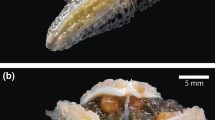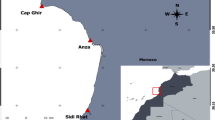Abstract
Ophiopholis mirabilis is a common species with a high population density on the western coasts of the northern Pacific Ocean. The number of O. mirabilis has been increasing recently in the scallop aquaculture zone (the Zhangzi Island area, northern Yellow Sea) in China. To explore the mechanism of its population variation, the reproductive cycle of O. mirabilis was investigated in this area (39°04’N; 122°51’E) from February 2017 through January 2018 and determined by the monthly gonad index (GI), histological examinations of the gonads and the oocyte size-frequency distribution. O. mirabilis had a clear annual reproductive cycle that was synchronous between males and females. Sea temperature and food availability played important roles in O. mirabilis reproduction. The GI value was less reliable for determining reproductive activity in O. mirabilis because the nutritive tissues within the gonads may be utilized to synthesize gametes, leading to a decrease in GI during maturation. The histological results also show that abundant nutritive phagocytes were present in the gonads of O. mirabilis, which, together with the germ cells, affected the weight of the gonads. In addition, the mature oocytes of O. mirabilis were relatively small (75–150 µm), indicating that the larval development was planktotrophic. This study provided insights into the reproductive patterns and biology of O. mirabilis and is an essential basis for the quantity control of this species in aquaculture areas.
Similar content being viewed by others
References
Aronson R B. 1989. Brittlestar beds: low-predation anachronisms in the British Isles. Ecology, 70(4): 856–865, https://doi.org/10.2307/1941354.
Blake S E. 1978. The Reproductive Cycle of Ophiopholis Aculeata (Echinodermata: Ophiuroidea) in the Northwestern Atlantic. University of Maine, Maine, USA.
Bourgoin A, Guillou M. 1990. Variations in the reproductive cycle of Acrocnida brachiata (Echinodermata: Ophiuroidea) according to environment in the Bay of Douarnenez (Brittany). Journal of the Marine Biological Association of the United Kingdom, 70(1): 57–66, https://doi.org/10.1017/S0025315400034196.
Brogger M I, Martinez M I, Zabala S, Penchaszadeh P E. 2013. Reproduction of Ophioplocus januarii (Echinodermata: Ophiuroidea): a continuous breeder in northern Patagonia, Argentina. Aquatic Biology, 19(3): 275–285, https://doi.org/10.3354/ab00537.
Byrne M. 1991. Reproduction, development and population biology of the Caribbean ophiuroid Ophionereis olivacea, a protandric hermaphrodite that broods its young. Marine Biology, 111(3): 387–399, https://doi.org/10.1007/BF01319411.
Carvalho A L P S, Ventura C R R. 2002. The reproductive cycle of Asterina stellifera (Möbius) (Echinodermata: Asteroidea) in the Cabo Frio region, southeastern Brazil. Marine Biology, 141(5): 947–954, https://doi.org/10.1007/s00227-002-0881-y.
Djakonov A M. 1954. Ophiuroidea of the Soviet Union. Tableaux Analytiques de la Faune de I’ URSS, 55: 1–136.
Doyle G M, Hamel J F, Mercier A. 2012. A new quantitative analysis of ovarian development in echinoderms: the maturity stage index. Marine Biology, 159(2): 455–465, https://doi.org/10.1007/s00227-011-1823-3.
Doyle G. 2011. Effect of Spatial and Environmental Factors on the Reproductive Cycle of the Brittle Star, Ophiopholis aculeata, Based on a New Maturity Stage Index. Memorial University, St. John’s, Canada.
Falkner I, Byrne M. 2003. Reproduction of Ophiactis resiliens (Echinodermata: Ophiuroidea) in New South Wales with observations on recruitment. Marine Biology, 143(3): 459–466, https://doi.org/10.1007/s00227-003-1066-z.
Falk-Petersen I B. 1982. Breeding season and egg morphology of echinoderms in Balsfjorden, northern Norway. Sarsia, 67(4): 215–221, https://doi.org/10.1080/00364827.1982.10421336.
Fedra K, Ölscher E M, Scherübel C, Stachowitsch M, Wurzian R S. 1976. On the ecology of a North Adriatic benthic community: distribution, standing crop and composition of the macrobenthos. Marine Biology, 38(2): 129–145, https://doi.org/10.1007/BF00390766.
Fenaux L. 1968. Maturation des gonades et cycle saisonnier des larves chez A. lixula, P. lividus et P. microtuberculatus à Villefranche-Sur-Mer. Vie et Milieu Série A Biologie Marine, 19: 1–52.
Fujita T, Ohta S. 1989. Spatial structure within a dense bed of the brittle star Ophiura sarsi (Ophiuroidea: Echinodermata) in the bathyal zone off otsuchi, northeastern Japan. Journal of Oceanography, 45(5): 289–300, https://doi.org/10.1007/BF02123483.
Gage J D, Tyler P A. 1991. Deep-Sea Biology: a Natural History of Organisms at the Deep-Sea Floor. Cambridge University Press, Cambridge. 504p, https://doi.org/10.1017/CBO9781139163637.
Giese A C, Pearse J S. 1974. Introduction: general principles. In: Giese A C, Pearse J S eds. Reproduction of Marine Invertebrates. Academic Press, New York. p.1–49, https://doi.org/10.1016/B978-0-12-282501-9.50006-5.
Harrington L H, Walker C W, Lesser M P. 2007. Stereological analysis of nutritive phagocytes and gametogenic cells during the annual reproductive cycle of the green sea urchin, Strongylocentrotus droebachiensis. Invertebrate Biology, 126(2): 202–209, https://doi.org/10.1111/j.1744-7410.2007.00090.x.
Hendler G, Tran L U. 2001. Reproductive biology of a deep-sea brittle star Amphiura carchara (Echinodermata: Ophiuroidea). Marine Biology, 138(1): 113–123, https://doi.org/10.1007/s002270000446.
Hendler G, Tyler P A. 1986. The reproductive cycle of Ophioderma brevispinum (Echinodermata: Ophiuroidea). Marine Ecology, 7(2): 115–122, https://doi.org/10.1111/j.1439-0485.1986.tb00151.x.
Hendler G. 1975. Adaptational significance of the patterns of ophiuroid development. American Zoologist, 15(3): 691–715, https://doi.org/10.1093/icb/15.3.691.
Hendler G. 1991. Echinodermata: ophiuroidea. In: Giese A C, Pearse J S, Pearse V B eds. Reproduction of Marine Invertebrates. Boxwood Press, Pacific Grove. p.355–511.
Himmelman J H, Dumont C P, Gaymer C F, Vallières C, Drolet D. 2008. Spawning synchrony and aggregative behaviour of cold-water echinoderms during multi-species mass spawnings. Marine Ecology Progress Series, 361: 161–168, https://doi.org/10.3354/meps07415.
King C K, Hoegh-Guldberg O, Byrne M. 1994. Reproductive cycle of Centrostephanus rodgersii (Echinoidea), with recommendations for the establishment of a sea urchin fishery in New South Wales. Marine Biology, 120(1): 95–106, https://doi.org/10.1007/BF00381945.
Li M, Zhang J H, Wu W G, Liu Y, Wang W, Lin F, Ma S, Yang Y Y. 2018. The spatial-temporal distribution of the suspended particulate matter in the water adjacent to the Zhangzidao Island. Progress in Fishery Sciences, 39(1): 54–63, https://doi.org/10.11758/yykxjz.20170107001. (in Chinese with English abstract)
Li X Z, Wang J B, Wang H F. 2016. Community structure of macrobenthos and seasonal variations in the Zhangzi Island waters of the northern Yellow Sea. Studia Marina Sinica, 51(1): 245–257, https://doi.org/10.11693/hyhz20151200304. (in Chinese with English abstract)
Liao Y L, Xiao N. 2011. Species composition and faunal characteristics of echinoderms in China seas. Biodiversity Science, 19(6): 729–736, https://doi.org/10.3724/SPJ.1003.2011.08155. (in Chinese with English abstra
Liu R Y. 2008. Checklist of Marine Biota of China Seas. Science Press, Beijing. 1 267p. (in Chinese)
Lozano J, Galera J, López S, Turon X, Palacin C, Morera G. 1995. Biological cycles and recruitment of Paracentrotus lividus (Echinodermata: Echinoidea) in two contrasting habitats. Marine Ecology Progress Series, 122: 179–191, https://doi.org/10.3354/meps122179.
Matsumoto H. 1941. Report of the biological survey of Mutsu Bay. Science Reports of the Tohoku University, 16: 331–344.
Meidel S K, Scheibling R E. 1998. Annual reproductive cycle of the green sea urchin, Strongylocentrotus droebachiensis, in differing habitats in Nova Scotia, Canada. Marine Biology, 131(3): 461–478, https://doi.org/10.1007/s002270050338.
Mercier A, Hamel J F. 2009. Endogenous and exogenous control of gametogenesis and spawning in echinoderms. Advances in Marine Biology, 55: 1–302, https://doi.org/10.1016/S0065-2881(09)55001-8.
Metaxas A, Giffin B. 2004. Dense beds of the ophiuroid Ophiacantha abyssicola on the continental slope off Nova Scotia, Canada. Deep Sea Research Part I: Oceanographic Research Papers, 51(10): 1 307–1 317, https://doi.org/10.1016/j.dsr.2004.06.001.
Nichols D, Barker M F. 1984. A comparative study of reproductive and nutritional periodicities in two populations of Asterias rubens (Echinodermata: Asteroidea) from the English Channel. Journal of the Marine Biological Association of the United Kingdom, 64(2): 471–484, https://doi.org/10.1017/S0025315400030137.
Pearse J S, Giese A C. 1966. Food, reproduction and organic constitution of the common Antarctic echinoid Sterechinus neumayeri (Meissner). The Biological Bulletin, 130(3): 387–401, https://doi.org/10.2307/1539745.
Rumrill S S, Pearse J S. 1985. Contrasting reproductive periodicities among north-eastern Pacific ophiuroids. In: Keegan B F, O’ Connor B D S eds. Echinodermata: Proceedings of the 5th International Echinoderm Conference, Galway. Balkema, Rotterdam. p.634–638.
Rumrill S S. 1984. Contrasting Reproductive Patterns Among Ophiuroids (Echinodermata) from Southern Monterey Bay, USA. University of California, Santa Cruz.
Scheibling R E, Hatcher B G. 2007. Ecology of Strongylocentrotus droebachiensis. Developments in Aquaculture and Fisheries Science, 37: 353–392, https://doi.org/10.1016/S0167-9309(07)80082-2.
Selvakumaraswamy P, Byrne M. 1995. Reproductive cycle of two populations of Ophionereis schayeri (Ophiuroidea) in New South Wales. Marine Biology, 124(1): 85–97, https://doi.org/10.1007/BF00349150.
Shin S, Rho B J. 1996. Illustrated Encyclopedia of Fauna and Flora of Korea. Ministry of Education, Seoul.
Shirai H, Walker C W. 1988. Chemical control of asexual and sexual reproduction in echinoderms. In: Laufer H, Downer R G H eds. Invertebrate Endocrinology, vol. 2, Endocrinology of Selected Invertebrate Types. Alan R. Liss, Inc., New York. p.453–476.
Skjaeveland S H. 1973. Ecology of echinoderms in Borgenfjorden, North-Trondelag, Norway. Kongelige Norske Videnskabers Selskab Museet, Miscellanea, 8: 1–51.
Stancyk S E. 1974. Life History Patterns of Three Estuarine Brittlestars (Ophiuroidea) at Cedar Key, Florida. University of Florida, Florida, https://doi.org/10.5962/bhl.title.37098.
Stewart B G, Mladenov P V. 1995. Reproductive periodicity in the euryalinid snake star Astrobrachion constrictum in a New Zealand fiord. Marine Biology, 123(3): 543–553, https://doi.org/10.1007/BF00349233.
Stöhr S, O’Hara T D, Thuy B. 2012. Global diversity of brittle stars (Echinodermata: Ophiuroidea). PLoS One, 7(3): e31940, https://doi.org/10.1371/journal.pone.0031940.
Valentine J F. 1991. Temporal variation in populations of the brittlestars Hemipholis elongata (Say, 1825) and Microphiopholis atra (Stimpson, 1852) (Echinodermata: Ophiuroidea) in eastern Mississippi Sound. Bulletin of Marine Science, 48(3): 597–605.
Vaschenko M A, Zhadan P M, Latypova E V. 2001. Long-term changes in the state of gonads in sea urchins Strongylocentrotus intermedius from Amur Bay, the Sea of Japan. Russian Journal of Ecology, 32(5): 358–364, https://doi.org/10.1023/A:1011982412642.
Walker C W, Harrington L M, Lesser M P, Fagerberg W R. 2005. Nutritive phagocyte incubation chambers provide a structural and nutritive microenvironment for germ cells of Strongylocentrotus droebachiensis, the green sea urchin. The Biological Bulletin, 209(1): 31–48, https://doi.org/10.2307/3593140.
Walker C W, Unuma T, Lesser M P. 2007. Gametogenesis and reproduction of sea urchins. Developments in Aquaculture and Fisheries Science, 37: 11–33, https://doi.org/10.1016/S0167-9309(07)80066-4.
Warner G F. 1979. Aggregation in echinoderms. In: Larwood G, Rosen B R eds. Biology and Systematics of Colonial Organisms Systematics Association Special Volume No. 11. Academic Press, London. p.375–396.
Yamashita M, Iwata F. 1983. A quantitative analysis of the annual testicular cycle of the brittle-star Amphipholis kochii by means of autoradiographic investigation. The Biological Bulletin, 164(2): 327–340, https://doi.org/10.2307/1541148.
Zhang J H, Fang J G, Wang S H. 2008. Carrying capacity for Patinopecten yessoensis in Zhang Zidao Island, China. Journal of Fisheries of China, 32(2): 236–241, https://doi.org/10.3321/j.issn:1000-0615.2008.02.010. (in Chinese with English abstract)
Zhang X, Luan Q S, Sun J Q, Du M R, Liang J, Zang Y C, Zhang Y, Wang J. 2016. Annual variation in phytoplankton community and its relationship with ambient environmental factors in adjacent waters of Zhangzi Island. Journal of Dalian Ocean University, 31(3): 315–323, https://doi.org/10.16535/j.cnki.dlhyxb.2016.03.016. (in Chinese with English abstract)
Acknowledgment
We would like to thank the captain and the crew of R/V Liaochangyu No. 19 for their help during the expedition to the Zhangzi Island area. Many thanks to those who helped with collections including ZHANG Yongshan, ZHAO Zengxia, WANG Shiwei, WAN Aiyong, XU Zhiqiang, LIU Mengtan, LIANG Yi, and WANG Jun from the Institute of Oceanology, Chinese Academy of Sciences (IOCAS). Thanks also to LIU Hourong from IOCAS for assistance with the histology and anonymous reviewers for comments on the manuscript.
Author information
Authors and Affiliations
Corresponding author
Additional information
Data Availability Statement
The datasets generated during and/or analyzed during the current study are available from the corresponding author on reasonable request.
Supported by the Strategic Priority Research Program of the Chinese Academy of Sciences (Nos. XDA23050501, XDA19060201), the Key Program for International S&T Cooperation Projects: Sino-Australian Center for Healthy Coasts (No. 2016YFE0101500), the Shandong Joint Fund for Marine Ecology and Environmental Sciences (No. U1606404), and the Taishan Scholars Project to SUN Song
Rights and permissions
About this article
Cite this article
Yu, N., Sun, S., Zhang, G. et al. Reproductive cycle of Ophiopholis mirabilis (Echinodermata: Ophiuroidea) in Zhangzi Island area, northern Yellow Sea. J. Ocean. Limnol. 39, 173–184 (2021). https://doi.org/10.1007/s00343-020-9317-0
Received:
Accepted:
Published:
Issue Date:
DOI: https://doi.org/10.1007/s00343-020-9317-0




